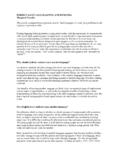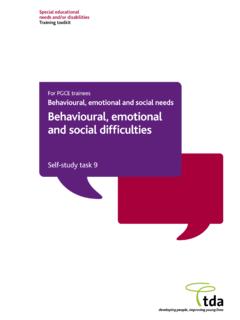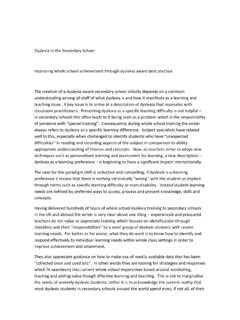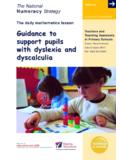Transcription of Dyslexia and specific learning difficulties – Self …
1 Special educational needs and/or disabilities Training toolkit For PGCE trainees Cognition and learning Dyslexia and specific learning difficulties self -study task 7. Introduction to the self -study tasks These self -study tasks are designed to help trainee teachers on PGCE courses learn more about teaching pupils with special educational needs (SEN) and/or disabilities. They can be used as stand- alone activities or to supplement and extend taught sessions on SEN and disability provided by the school or local authority. There are 17 self -study tasks in all. Each task will take about two hours to complete, excluding practical activities. Every Child Matters SST1 Inclusion and Every Child Matters SST2 SEN and disability legislation SST3 English as an additional language and SEN. SST4 Children's needs and development SST5 ICT and SEN. Cognition and learning SST6 Moderate learning difficulties SST7 Dyslexia and specific learning difficulties SST8 Working memory Behavioural, emotional and social needs SST9 Behavioural, emotional and social difficulties Communication and interaction SST10 Speech, language and communication needs SST11 Autistic spectrum disorders Physical and sensory impairment SST12 Visual impairment SST13 Hearing impairment SST14 Handwriting SST15 Developmental coordination disorder/dyspraxia Working in partnership SST16 Working with colleagues in school SST17 Working with parents/carers and other professionals self -study Session 3 task 7 2.
2 Overviewand Dyslexia of the specific inclusion learning statement difficulties Development Cognition andand learning diversity How to use the materials This is an online resource. Some of the tasks are for you to do on your own; others are particularly suitable to do working with a partner. Where some of the tasks ask you to record information you need to print out the relevant material first. Other tasks may involve using the internet, which gives you access to rich sources of information about SEN and disability and online forums for additional advice. Each task includes the following elements: "" the professional standards addressed "" learning outcomes "" an opportunity to explore the concepts, definitions and research findings most relevant to the topic "" ideas for implementing the national curriculum inclusion statement in relation to the topic, including target setting, practical strategies, the role of additional adults and pupil grouping "" practical activities including action research, child study and class observation "" resources including books and websites "" an opportunity to evaluate your progress against the outcomes and plan your next steps.
3 A useful resource to support your studies is Implementing the Disability Discrimination Act in Schools and Early Years Settings (DfES, 2006). It is available free to all schools and there should be a copy in your training institution or school. (If you haven't got a copy, you can order one using the link.). It should be read in conjunction with Promoting Disability Equality in Schools (DfES, 2006) . which you can view, download or order by following the link. Evidence and sources of information As you work through these self -study tasks, try to keep a critical and evaluative attitude. Much of the understanding we have of what works, or doesn't work, in relation to meeting the needs of pupils with SEN and/or disabilities has not been fully researched. Remember: "" many interventions suggested for one group of pupils with SEN and/or disabilities will often benefit other groups of pupils, including those without SEN and/or disabilities "" the quickest way to find out what to do is often to ask the pupil or their parent/carer what they think works.
4 Literature reviews of what works' in relation to literacy and mathematics for pupils with SEN. and/or disabilities, which has been investigated in some depth, are available at: research/data/ Other sources of information are listed at the end, under Resources and references'. You can use these to follow up and learn in greater depth about the material covered in this self -study task. self -study Session 3 task 7 3. Overviewand Dyslexia of the specific inclusion learning statement difficulties Development Cognition andand learning diversity self -study task 7. Dyslexia and specific learning difficulties Professional standards addressed Q10 Have a knowledge and understanding of a range of teaching, learning and behaviour management strategies and know how to use and adapt them, including how to personalise learning and provide opportunities for all learners to achieve their potential. Q19 Know how to make effective personalised provision for those they teach, including those for whom English is an additional language or who have special educational needs or disabilities, and how to take practical account of diversity and promote equality and inclusion in their teaching.
5 Q25 Teach lessons and sequences of lessons across the age and ability range for which they are trained in which they: (a) use a range of teaching strategies and resources, including e- learning , taking practical account of diversity and promoting equality and inclusion (b) build on prior knowledge, develop concepts and processes, enable learners to apply new knowledge, understanding and skills and meet learning objectives (c) adapt their language to suit the learners they teach, introducing new ideas and concepts clearly, and using explanations, questions, discussions and plenaries effectively (d) demonstrate the ability to manage the learning of individuals, groups and whole classes, modifying their teaching to suit the stage of the lesson. learning outcomes You will: "" understand current definitions of Dyslexia "" be aware of some of the barriers to participation and learning experienced by dyslexic pupils, and "" be familiar with some of the approaches that support dyslexic pupils' learning .
6 self -study task 7 4. Dyslexia and specific learning difficulties Cognition and learning Activities Timings Activity 1 Developing your knowledge of Dyslexia 25 minutes Activity 2 Planning for dyslexic pupils: gathering information 25 minutes Activity 3 A Dyslexia -friendly learning environment 20 minutes Activity 4 Planning for individuals 25 minutes Activity 5 Supporting reading 15 minutes Activity 6 Including pupils with Dyslexia 15 minutes Activity 7 Points for action 15 minutes Resources and references Appendix Suggested answers and solutions Session 3 task 7. self -study 5. Overviewand Dyslexia of the inclusion specific statement learning difficulties Development Cognition andand learning diversity Activity 1. Developing your knowledge of Dyslexia Approximate timing: 25 minutes 25 mins Introduction The most authoritative statement to date of the evidence on issues and interventions in relation to Dyslexia is the report commissioned by the Secretary of State for Children, Schools and Families from Sir Jim Rose, published in 2009 (Rose, 2009).
7 The Secretary of State has accepted all its recommendations so they have become government policy. Skim-read Identifying and Teaching Children and Young People with Dyslexia and Literacy difficulties online at Defining Dyslexia As you would expect, there has been substantial investigation of Dyslexia , and this has resulted in a range of definitions. Jim Rose's report gives its own definition (note that this does not assign a cause to Dyslexia , but describes it in terms of the behaviours associated with it): "" Dyslexia is a learning difficulty that primarily affects the skills involved in accurate and fluent word reading and spelling. "" Characteristic features of Dyslexia are difficulties in phonological awareness, verbal memory and verbal processing speed. "" Dyslexia occurs across the range of intellectual abilities. "" It is best thought of as a continuum, not a distinct category, and there are no clear cut-off points. "" Co-occurring difficulties may be seen in aspects of language, motor coordination, mental calculation, concentration and personal organisation, but these are not, by themselves, markers of Dyslexia .
8 "" A good indication of the severity and persistence of dyslexic difficulties can be gained by examining how the individual responds or has responded to well founded intervention.. Rose, 2009. Effective support for dyslexic pupils Teachers can now adopt many interventions that have been tested and found to be successful in supporting dyslexic pupils and enabling them to make progress in reading. This self -study task will introduce you to a range of these. Research suggests that strong and effective teaching of literacy, embodying the principles set out in the work of such authors as Torgesen (2002), can minimise the barriers to participation and learning for pupils with Dyslexia . Intensive preventive instruction can bring the average word-reading skills of children at risk for reading disabilities solidly into the average range.. Torgesen, 2002. self -study Session 3 task 7 6. Overviewand Dyslexia of the specific inclusion learning statement difficulties Development Cognition andand learning diversity What do you know about Dyslexia ?
9 Check how much you already know about Dyslexia by answering the questions in table 1. Reading Identifying and Teaching Children and Young People with Dyslexia and Literacy difficulties may help with some of the answers. Table 1: Dyslexia true or false? Statement True or false? Dyslexia occurs across the ability range There are dyslexic pupils in every classroom, and dyslexic adults in most staffrooms Of the UK population, four per cent are severely dyslexic, and an estimated 10 per cent are mildly dyslexic Dyslexia is a learning difference a combination of strengths and weaknesses, which affect the learning process in reading, spelling, writing and sometimes number and calculation Dyslexic learners may also have weaknesses in short-term memory, sequencing and the speed with which they process information Dyslexia has a physiological basis research indicates neurological differences, generally affecting the left hemisphere, which deals with language and sequential processing Dyslexia runs in families Dyslexia occurs on a continuum from mild to severe Dyslexia occurs in all ethnic groups and in all languages People with Dyslexia often have low self -esteem.
10 Which can lead to reduced motivation and sometimes to behaviour problems Dyslexic learners can do as well as anyone else when they are given appropriate support self -study Session 3 task 7 7. Overviewand Dyslexia of the specific inclusion learning statement difficulties Development Cognition andand learning diversity How did you get on? All the answers are true! A learning difference The British Dyslexia Association (BDA)1 has suggested that we should see Dyslexia as a learning difference'. Note the emphasis given to identifying the dyslexic learner's strengths in the two sections below, which are adapted from the BDA's pack Achieving Dyslexia Friendly Schools. Dyslexia is a combination of strengths and weaknesses, which affect the learning process in reading, spelling, writing and sometimes number and calculation. Dyslexic learners may also have accompanying weaknesses in short-term memory, sequencing and the speed at which they process information. In the past, Dyslexia has been referred to as a learning difficulty.

















